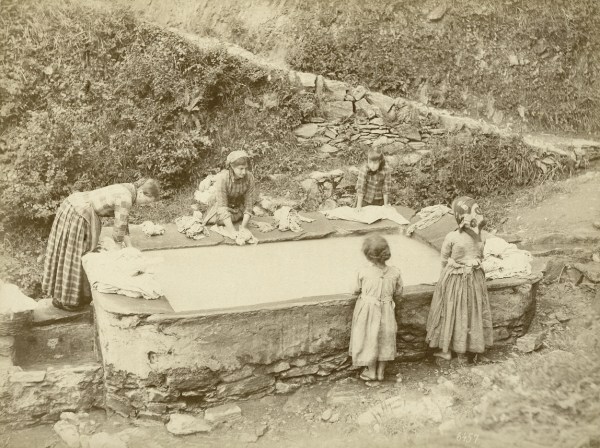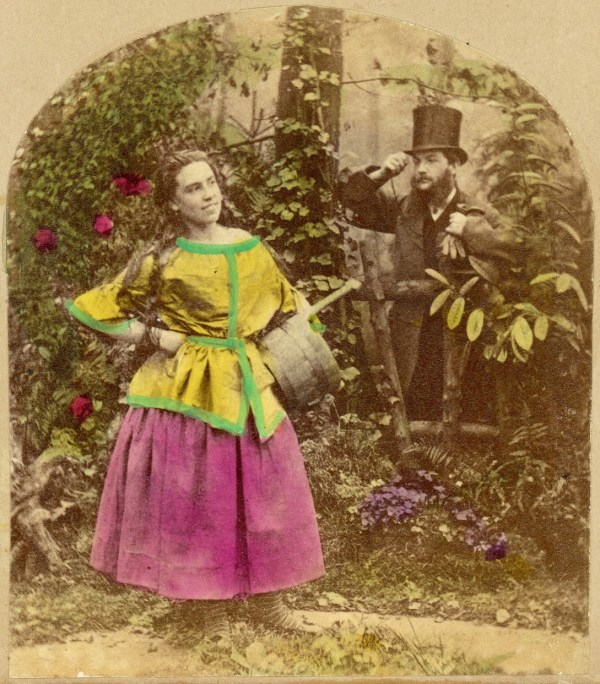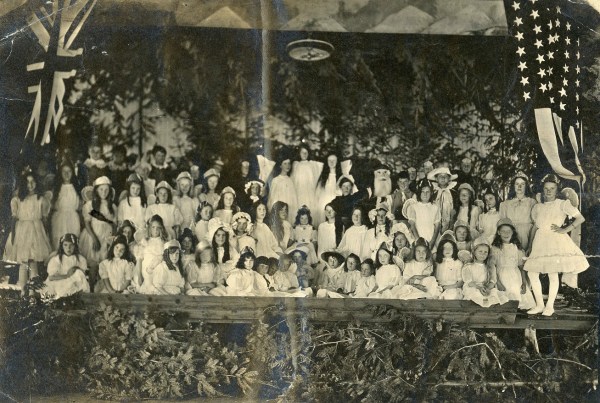This view of women and girls working was captured by the German-Italian photographer Alfredo Noack (1833-1895). Born August Alfred Noack in Dresden in 1833, he moved to Italy in his early twenties, first living in Rome (1856-1860) and then moving to Genoa, where he opened a photography studio. He lived in Genoa for the rest... Continue Reading →
Observation balloon in Switzerland
Balloons have been in the news a lot recently here in North America. The idea of "spy balloons" may seem amusing today, but observation balloons have long been used for military purposes, most notably during the First World War. The postcard photo above may have been taken near the end of the war, or it... Continue Reading →
We’ll take a cup of kindness yet
This carte-de-visite photo has no information on it about who took it or where. I found it in Massachusetts, but assume it must have originated in Europe. In the 1860s and 1870s, European photographers began employing young people from their communities to dress in national costumes and pose against studio backdrops designed to represent local... Continue Reading →
The American Fund for French Wounded
The photo above was taken in Boston, Massachusetts, during the First World War. A press snipe on the back provides some information: This is a typical load of supplies sent weekly by the American Fund for French Wounded, 304-306 Boylston Street to the French military hospitals. The men seem to be in good spirits: ... Continue Reading →
Major Mouton and Beauséjour
The message on the back of this postcard was written 105 years ago by a French serviceman during the First World War. The writer was not the man pictured on the front of the postcard. The message is signed simply Camille. I can't quite make out the name of the intended recipient or the town... Continue Reading →
Nurses in Bombay by Clifton and Company
The women in this photograph are unidentified. Fortunately, the mount is stamped Clifton & Co., Bombay, indicating that the photo was taken at the studio founded in that city (Mumbai) by Harry Clifton Soundy (1863-1922). At first I assumed the woman sitting at left was wearing a County or Branch badge of the British Red... Continue Reading →
Who are these men?
This post is a work in progress. At the time that I published it, I hadn't managed to identify any of the men in the photo. A resourceful reader in the UK, Michael, quickly identified two of them. The man seated in the middle of the second row is Frederic Thesiger, Viscount Chelmsford, who was... Continue Reading →
Graduates of St. Teresa’s Academy in Boise, Idaho
On the back of this photograph is a handwritten note: Friends of Doris Dinwiddie at St. Terresa [sic] Academia (Early graduates of) I searched online for St. Teresa Academia, but was stumped because there were too many possibilities. So I looked on Ancestry and found family trees containing Doris Cecil Dinwiddie Crawford (1893-1968). A photo of... Continue Reading →
“Nobody axed you, Sir,” she said
Where are you going, my pretty maid?I'm going a milking, sir, she said.May I go with you, my pretty maid?You're kindly welcome, sir, she said.What is your father, my pretty maid?My father's a farmer, sir, she said.What is your fortune, my pretty maid?My face is my fortune, sir, she said.Then I won't marry you, my... Continue Reading →
Young man with ice skates in Uppsala, Sweden
With the Winter Olympics in full swing, I thought it might be fun to share this carte-de-visite portrait of a young man holding a pair of ice skates in Uppsala, Sweden. Nineteenth-century images of people dressed specifically for winter sports are relatively rare. Because of the limitations of early cameras and photographic processes, such portraits... Continue Reading →
Children’s pageant in British Columbia
In 2011 I bought an album of family snapshots from British Columbia. No one in the album is identified by last name, so I haven't been able to identify the family. Some of the photographs were taken during the years 1915-1917, according to handwritten annotations. A girl named Hazel appears in many of them, so... Continue Reading →
Charles and Susan Crippen
The portrait above is an ambrotype, or photograph on glass, by an unknown photographer. Ambrotypes were introduced in the United States in the early 1850s and remained popular for about a decade. They were simpler and less costly to produce than daguerreotypes. Eventually they were replaced by tintypes and albumen paper prints (such as the... Continue Reading →


















Recent Comments